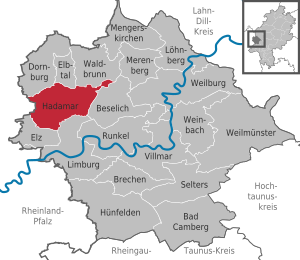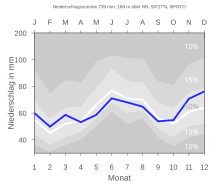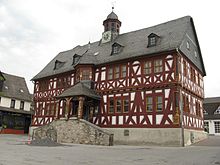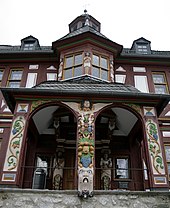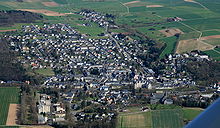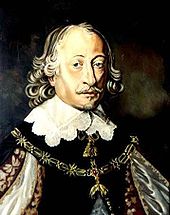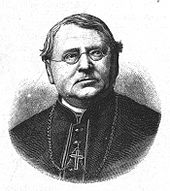Hadamar
| coat of arms | Germany map | |
|---|---|---|

|
Coordinates: 50 ° 27 ' N , 8 ° 3' E |
|
| Basic data | ||
| State : | Hesse | |
| Administrative region : | to water | |
| County : | Limburg-Weilburg | |
| Height : | 129 m above sea level NHN | |
| Area : | 40.99 km 2 | |
| Residents: | 12,528 (Dec. 31, 2019) | |
| Population density : | 306 inhabitants per km 2 | |
| Postal code : | 65589 | |
| Area code : | 06433 | |
| License plate : | LM, WEL | |
| Community key : | 06 5 33 007 | |
| LOCODE : | DE HAD | |
| City structure: | 6 districts | |
City administration address : |
Untermarkt 1 65589 Hadamar |
|
| Website : | ||
| Mayor : | Michael Ruoff ( CDU ) | |
| Location of the town of Hadamar in the Limburg-Weilburg district | ||
Hadamar is a town in the Limburg-Weilburg district in central Hesse .
It borders on the district town of Limburg an der Lahn and lies between Cologne and Frankfurt am Main on the southern edge of the Westerwald am Elbbach at an altitude of 120 to 390 m above sea level. NN .
Hadamar is also known for the Vitos Clinic for Psychiatry and Psychotherapy Hadamar , located on the outskirts, with the Hadamar Memorial in the outbuildings . It commemorates the murder of people with disabilities and mental illnesses during the Nazi era in the Hadamar Sanatorium, which was used as a killing facility .
geography
Neighboring communities
Hadamar borders in the north on the communities Dornburg , Elbtal and Waldbrunn , in the east on the community Beselich , in the south on the city Limburg and the community Elz (all in the district Limburg-Weilburg), and in the west on the community Hundsangen (in the Westerwald district in Rhineland-Palatinate ).
geology
The lower soil layers in the Hadamar area consist of weathered basalt, scarf stone, diabase and slate. They are covered with thick layers of loess .
climate
The annual precipitation is 739 mm and is therefore comparatively normal, as it falls in the middle third of the values recorded in Germany. Lower values are registered at 49% of the measuring stations of the German Weather Service . The driest month is February, with the most rainfall in December. In December there is 1.5 times more rainfall than in February. The precipitation hardly varies and is very evenly distributed over the year. Lower seasonal fluctuations are recorded at only six percent of the measuring stations.
Forest
Hadamar City has 612 hectares of forest holdings. The largest part of this area is located in the area of the Niederhadamar district with almost 206 hectares, followed by Niederzeuzheim with 179 hectares, Steinbach with almost 91, Oberzeuzheim with 72, Oberweyer with 35 and the city center with almost 30 hectares. The forest in the Hadamar district belongs to the "Northern Limburg Basin" growth area. The tree species in urban forests are divided into 38 percent beech, 26 percent spruce, 17 percent oak, 13 percent other hardwood species, three percent pine, two percent Douglas fir and one percent larch.
City structure
The city consists of six official districts.
| district | Inhabitants 1910 |
Residents today |
Area in km² |
Population density inhabitants / km² |
|---|---|---|---|---|
| Hadamar (core city) | 2,735 | 3,649 | 7.54 | 483.9 |
| Niederhadamar (to the core city) | 1,193 | 3,959 | 8.5 | 465.7 |
| Faulbach (to the city center) | 138 | 148 | * | * |
| Niederweyer | 132 | 203 | 1.36 | 149.3 |
| Niederzeuzheim | 877 | 1,456 | 7.65 | 190.3 |
| Oberzeuzheim | 673 | 1,267 | 6.61 | 191.7 |
| Steinbach | 641 | 1,257 | 6.15 | 204.4 |
| Oberweyer | 560 | 859 | 4.16 | 206.5 |
| Hadamar city as a whole | 6,811 | 12,798 | 40.99 | 312.2 |
* The information on the area and population density of Faulbach are contained in those of the core city.
history
The name of the city itself was first mentioned as Hatimer in 832 in a Carolingian barter. The city first became more important in 1320, when Count Emich founded the older line of the House of Nassau-Hadamar and had a moated castle built on the basis of a former Cistercian monastery . In 1324 Hadamar received city rights and shortly thereafter a city wall . After the older Nassau-Hadamar line died out in 1394, inheritance disputes and division of the city between the House of Nassau and other noble houses followed. On March 14, 1540 there was a devastating fire disaster. The entire city burned down except for three houses.
A comprehensive urban redevelopment followed under the count, later prince, Johann Ludwig von Nassau-Hadamar (1590-1653), who founded the younger line of the house of Nassau-Hadamar and made Hadamar his residence. Above all, the old moated castle was expanded into a baroque palace and several Catholic orders were settled. Among them was the Jesuit order , which laid the foundation for the supra-local importance of Hadamar as a school location with its monastery and grammar school. With the "Hadamar Baroque" a variant of this cultural epoch developed in the residential city that was significant beyond the local area.
With Johann Ludwig's grandson Franz Alexander, the younger Nassau-Hadamar line died out in 1711. A dispute over the legacy ensued between the numerous branches of the House of Nassau, from which Nassau-Diez emerged victorious. Hadamar remained the center for the administration of several municipalities in the surrounding area. In 1815 the city became part of the Duchy of Nassau and in 1866 of Prussia. In 1870 the city was connected to the railroad.
The psychiatric hospital founded in 1883 became the Nazi extermination center Hadamar from 1941 , in which an estimated at least 14,494 handicapped, mentally ill, so-called “half-Jews” and “Eastern workers” were murdered. Today a memorial commemorates these crimes.
Aided by the settlement of some German-speaking refugee families from the Sudetenland after the Second World War , the nationally known Erwin Stein Glass School was established.
Incorporations
On December 31, 1971, as part of the regional reform in Hesse, the previously independent communities Niederweyer, Niederzeuzheim, Oberweyer, Oberzeuzheim and Steinbach were incorporated.
Territorial history and administration
The following list gives an overview of the territories in which Hadamar was located or the administrative units to which it was subordinate:
- from 7th century: domain of the Counts of Niederlahngau
- 12th century to 1332: Grafschaft Diez and Grafschaft Leiningen
- 1332–1394: Holy Roman Empire , Nassau-Hadamar County
- 1394–1405: Holy Roman Empire, disputed between the County of Nassau-Dillenburg and County of Katzenelnbogen
- 1405–1479: Holy Roman Empire, condominium between the County of Nassau-Dillenburg and County of Katzenelnbogen
- 1479–1492: Holy Roman Empire, condominium between the County of Nassau-Dillenburg and the Landgraviate of Hesse (Hessian pledging of the share from 1492 to 1557)
- 1492–1522: Holy Roman Empire, condominium between the County of Nassau-Dillenburg and the Lords of Eppstein
- 1522–1535: Holy Roman Empire, condominium between the County of Nassau-Dillenburg and the Lords of Königstein
- 1535–1557: Holy Roman Empire, condominium between the County of Nassau-Dillenburg and the Counts of Stolberg-Königstein
- 1557–1607: Holy Roman Empire, County of Nassau-Dillenburg
- 1607–1711: Holy Roman Empire, Principality of Nassau-Hadamar , Hadamar Office
- 1717–1743: Holy Roman Empire, Principality of Nassau-Dillenburg , Hadamar Office
- 1743–1806: Holy Roman Empire, Counts of Nassau-Diez as part of the Principality of Nassau-Orange , Hadamar Office
- 1806–1813: Grand Duchy of Berg , Department of Sieg , Canton Hadamar
- 1813–1815: Principality of Nassau-Orange , Hadamar Office
- from 1816: German Confederation , Duchy of Nassau , Hadamar Office
- from 1849: German Confederation, Duchy of Nassau, Hadamar District Office
- from 1854: German Confederation, Duchy of Nassau, Hadamar Office
- from 1867: North German Confederation , Kingdom of Prussia , Province of Hessen-Nassau , Administrative Region of Wiesbaden , Oberlahnkreis
- from 1871: German Empire , Kingdom of Prussia, Province of Hessen-Nassau, administrative district of Wiesbaden, Oberlahnkreis
- from 1886: German Empire, Kingdom of Prussia, Province of Hesse-Nassau, District of Wiesbaden, District of Limburg
- from 1918: German Empire, Free State of Prussia , Province of Hesse-Nassau, District of Wiesbaden, District of Limburg
- from 1944: German Empire, Free State of Prussia, Nassau Province , Limburg District
- from 1945: American zone of occupation , Greater Hesse , Wiesbaden district, Limburg district
- from 1949: Federal Republic of Germany , State of Hesse , Wiesbaden district, Limburg district
- from 1968: Federal Republic of Germany, State of Hesse, administrative district Darmstadt , district Limburg
- from 1974: Federal Republic of Germany, State of Hesse, administrative district Darmstadt, district Limburg-Weilburg
- from 1981: Federal Republic of Germany, State of Hesse, Gießen district, Limburg-Weilburg district
population
Population development
Source: Historical local dictionary
| • 1566: 55 houses |
| • 1644: 75 citizens and 44 sojourners |
| • 1793: 272 houses |
| • 1950: 6003 inhabitants (of which 1207 refugees) |
| Hadamar: Population from 1810 to 2015 | ||||
|---|---|---|---|---|
| year | Residents | |||
| 1810 | 1,481 | |||
| 1817 | 1,486 | |||
| 1819 | 1,374 | |||
| 1829 | 1,878 | |||
| 1834 | 3,072 | |||
| 1840 | 3,312 | |||
| 1846 | 3,486 | |||
| 1852 | 3,538 | |||
| 1858 | 3,524 | |||
| 1864 | 3,627 | |||
| 1871 | 3,371 | |||
| 1875 | 3,340 | |||
| 1885 | 3,595 | |||
| 1895 | 3,497 | |||
| 1905 | 3,723 | |||
| 1910 | 4,067 | |||
| 1925 | 4,397 | |||
| 1939 | 4,375 | |||
| 1946 | 5,426 | |||
| 1950 | 6.003 | |||
| 1956 | 6.007 | |||
| 1961 | 5,905 | |||
| 1967 | 6.319 | |||
| 1970 | 6,419 | |||
| 1972 | 10,867 | |||
| 1976 | 10,428 | |||
| 1984 | 10,746 | |||
| 1992 | 11,037 | |||
| 2000 | 12,300 | |||
| 2010 | 12,210 | |||
| 2015 | 12,400 | |||
| Data source: Historical municipality register for Hesse: The population of the municipalities from 1834 to 1967. Wiesbaden: Hessisches Statistisches Landesamt, 1968. Further sources:; 1972 :; 1976 :; 1984 :; 1992 :; 2000, 2015 :; 2010: The figures from 1972 also include the incorporated places after the regional reform in Hesse . | ||||
Religious affiliation
Source: Historical local dictionary
| • 1885: | 448 Protestant (= 19.01%), 1803 Catholic (= 76.50%) and 106 Jewish (= 4.50%) residents |
| • 1961: | 984 Protestant (= 16.66%), 4858 Roman Catholic (= 82.05%) residents |
politics
City Council
The local elections on March 6, 2016 produced the following results, compared to previous local elections:
| Parties and constituencies | % 2016 |
Seats 2016 |
% 2011 |
Seats 2011 |
% 2006 |
Seats 2006 |
% 2001 |
Seats 2001 |
||
|---|---|---|---|---|---|---|---|---|---|---|
| CDU | Christian Democratic Union of Germany | 40.7 | 15th | 42.9 | 16 | 37.0 | 14th | 50.6 | 19th | |
| SPD | Social Democratic Party of Germany | 20.5 | 8th | 21.0 | 8th | 17.3 | 6th | 29.7 | 11 | |
| FWG | Hadamar Free Community of Voters | 22.5 | 8th | 20.1 | 7th | 23.6 | 9 | 19.7 | 7th | |
| WfH | We for Hadamar | 16.3 | 6th | 12.5 | 5 | 22.1 | 8th | - | - | |
| FDP | Free Democratic Party | - | - | 2.1 | 1 | - | - | - | - | |
| THE LEFT | The left | - | - | 1.3 | 0 | - | - | - | - | |
| total | 100.0 | 37 | 100.0 | 37 | 100.0 | 37 | 100.0 | 37 | ||
| Voter turnout in% | 44.9% | 43.4% | 44.5% | 48.0% | ||||||
mayor
Michael Ruoff (CDU) was re-elected in June 2015.
City arms
Blazon : In blue two crossed silver swords with gold hilt and gold quillons accompanied by four floating silver crosses.
Reason : The Hadamar city coat of arms comes from a seal that was used in the city of Hadamar and the Hadamar region as early as the end of the 15th century. The crosses in the coat of arms are to be interpreted as symbols of peace and the crossing swords as symbols of power.
Town twinning
- since 1973: Bellerive-sur-Allier , France

- since 1991: Impruneta , Italy

In October 1973 the twinning with the French city of Bellerive-sur-Allier was sealed by signing and presenting the sisterhood certificate. They solemnly vowed to maintain the permanent ties between the city administrations of both cities, to support the exchange of their inhabitants in all areas and to promote the vigilant feeling of European fraternity and to contribute to European unity through better mutual understanding.
Since 1991 there has been a partnership with the Italian city of Impruneta near Florence.
Culture and sights
Buildings
Numerous half-timbered buildings have been preserved in the old town , including the town hall (built in 1639) and the Jesuit boarding school (early 17th century) at the Limburg gate.
Several churches were built in Hadamar. The Gothic Church of Our Lady on the Elbbach was built before 1376 as a Gothic hall church and served as the town church until 1818. It was also the destination of a lively pilgrimage to Mary . The Gothic interior was destroyed or sold during the Reformation. In 1738 today's main altar was created in the baroque sculpture school of the princely city. The "Marienglocke", which rings out in the tower of the Liebfrauenkirche, dates from 1451 and is one of the oldest bells in Germany that is still in use. The current baroque town church of St. Johannes Nepomuk is part of the Jesuit residence (built in 1756/58). The castle church in the east wing of the castle has been the church of the Evangelical parish of Hadamar since 1791.
The Aegidienkirche on the Mönchsberg was part of the Franciscan monastery from 1632 to 1816. 31 members of the Nassau-Hadamar family are buried there. Above the old town is the baroque Herzenberg chapel (built around 1676), in which the hearts of the Hadamar princes are buried. All churches are elaborately designed in the Hadamar Baroque style.
The synagogue building has also been preserved. Today the building houses a permanent exhibition on Jewish life.
On the edge of the old town, directly on the Elbbach, is the former Nassau residence, Hadamar Castle , in whose stables the city museum is housed. Two old bridges, the Stone Bridge and the St. Wendelin Bridge, have been preserved in the Hadamar area .
The imposing Konvikt building, visible from afar, towers over the city .
Parks
A rose garden was laid out at the Herzenberg chapel. Around 2,000 rose bushes of over 160 different varieties are planted on an area of around 3,000 m².
Economy and Infrastructure
Hadamar is shaped by its history as an administrative center. There are no larger industrial companies. The largest employer in the city is the Center for Social Psychiatry, a psychiatric hospital of the State Welfare Association of Hesse on the Mönchberg.
traffic
The city of Hadamar is located on the federal highway 54 from Siegen to Wiesbaden .
Hadamar is located on the Oberwesterwaldbahn with the stations Niederhadamar, Hadamar and Niederzeuzheim, which are served by the trains of the regional train line RB 90 ("Westerwald-Sieg-Bahn") of the Hessian State Railway. Of Limburg an der Lahn cities are Koblenz , Frankfurt and Wiesbaden can be reached directly from Au from Cologne .
education
There are five primary schools in the city of Hadamar: One each in Hadamar, Niederhadamar, Niederzeuzheim, Oberzeuzheim and Steinbach.
The further Fürst-Johann-Ludwig-Schule functions as a cooperative comprehensive school with main , secondary and high school branches . The catchment area of the Fürst-Johann-Ludwig-Schule extends far beyond the city of Hadamar, as it is one of the largest cooperative schools in Hesse.
Hadamar is also a center for glazier training . The Federal Technical School of the Glazier Trade and the Erwin-Stein School (State Glass Technical School) are located here. The Erwin Stein School is named after Erwin Stein , one of the fathers of the Hessian state constitution. Since 2010, the St. Anna Health Center has housed a vocational school for nursing professions.
Hadamar is the seat of the musical boarding school, the educational establishment of the Limburg Cathedral Boys' Choir .
The educational institutes Wetzlar-Lahn-Dill-Eder and Limburg, based in Hadamar, are two of the nine district educational institutes of the Limburg diocesan educational institute .
Facilities
- Catholic day care center Marienfried Hadamar
- Catholic daycare / family center St. Ursula Niederhadamar
- Ev. Theodor Fliedner Niederhadamar daycare center
- Catholic day care center St. Petrus Niederzeuzheim
- Catholic day care center St. Antonius Oberzeuzheim
- Catholic day care center Maria Heimsuchung Steinbach
- Catholic day care center St. Leonhard Oberweyer
- Crèche Krabbelstube Bimsalasim Niederhadamar
- Intercommunal day care center Villa Musica Hadamar
- Hadamar volunteer fire brigade , founded in 1869 (with youth fire brigade since February 28, 1978 )
- Niederhadamar volunteer fire brigade, founded in 1902 (with youth fire brigade since March 1, 1973)
- Niederzeuzheim volunteer fire brigade, founded in 1921 (since January 1, 1970 with youth fire brigade and since April 4, 2009 with children's fire brigade )
- Oberweyer volunteer fire brigade, founded in 1928 (since May 1, 1975 with youth fire brigade)
- Voluntary fire brigade Oberzeuzheim, founded in 1929 (since 1970 with music department and since September 1, 1975 with youth fire brigade)
- Steinbach volunteer fire brigade, founded in 1913 (with youth fire brigade since June 14, 1980)
- Social center of the workers' welfare
- St. Anna health center with retirement home, nursing school and various medical practices in the building of the former hospital
societies
- Carnival Society 1928 Hadamar e. V.
- SV Red-White Hadamar
Personalities
sons and daughters of the town
- Christian Egenolff (1502–1555), printer
- Georg Lorich (around 1533 – after 1588), legal scholar, diplomat and high administrative officer in several principalities in the 16th century
- Peter Melander von Holzappel (1589–1648), general in the Thirty Years War
- Moritz Heinrich von Nassau-Hadamar (1626–1679), regent of Nassau-Hadamar
- Franz Alexander von Nassau-Hadamar (1674–1711), last Prince of Nassau-Hadamar
- Christian Schmidt (1708–1753), Nassau carpenter
- Thomas Holtzclau (1716–1783), theologian and university professor
- Johann Wilhelm Bausch (1774–1840), Bishop of Limburg
- Viktor Joseph Dewora (1774–1837), cathedral capitular, cathedral preacher and bishop's council in Trier
- Joseph Muth (1788–1866), teacher and historian
- Ludwig von Preuschen von und zu Liebenstein (1806–1864), lawyer, archivist and heraldist
- Leonhard Diefenbach (1814–1875), teacher and painter
- Karl Braun (1822-1893), politician
- Joseph Weyland (1826–1894), Bishop of Fulda
- Wilhelm Tripp (1835–1916), parish priest and cathedral capitular in Limburg
- Franz Alfred Muth (1839–1890), Catholic clergyman and poet
- Wilhelm Hartmann (politician, 1848) (1848–1913), German politician, Mayor of Hadamar, MdPL Hessen-Nassau
- Karl Wilhelm Diefenbach (1851–1913), painter
- Gustav Ricker (1870–1948), doctor and scientist
- Karl Faust (1874–1952), botanist
- Maria Mathi (1889–1961), writer
- Hans Günther Bastian (1944–2011), music teacher
- Thomas Balkenhol (* 1950), author and filmmaker
- Bernhard Balkenhol (* 1951), university professor and artist
- Josef Blotz (* 1956), major general in the Bundeswehr
- Thomas Weikert (* 1961), President of the German Table Tennis Federation DTTB and the World Association ITTF
- Markus Graulich (* 1964), religious and canon lawyer
- Joachim Valentin (* 1965), Roman Catholic theologian
- Udo Noll (* 1966), German media artist
- Ruth Stock-Homburg (* 1972), Professor of Business Administration
- Claudia Salman-Rath (* 1986), heptathlete
- Marcel Reichwein (* 1986), soccer player
- André Rudersdorf (* 1995), automobile racing driver
Personalities who worked in Hadamar
- Johann Ludwig von Nassau-Hadamar (1590–1653), regent, imperial plenipotentiary and signatory of the peace treaty for the Peace of Westphalia
- Carl Wirth (1810–1880), President of the Nassau state parliament and bailiff in Hadamar
- Ernst Moritz Engert (1892–1986), silhouette artist and painter
- Erhard Theodor Astler (1914–1998), painter, graphic artist and draftsman; Lecturer at Hadamar School of Glass
- Ludwig Wollenheit (* 1915), German painter and draftsman; Lecturer at Hadamar School of Glass
- Josef Welzel (1927–2014), German experimental archaeologist and glass artist
- Hermann Bellinger (* 1926), honorary citizen and honorary mayor
Other personalities
- Anke Olschewski (* 1962), table tennis player, lives in Hadamar
- Rea Garvey (* 1973), Irish singer and guitarist, lives next to Berlin with his wife in their home town Hadamar
See also
- Hadamar Higher Appeal Court , between 1804 and 1806 the joint Higher Appeal Court of the Nassau principalities with its seat in Hadamar
literature
- Karl Josef Stahl: Hadamar town and castle. A home story. Hadamar City Council, 1974.
- Jürgen Lanio: Hadamar residence city of the princes of Nassau-Hadamar. Horb am Neckar, Geiger, 2011.
- Literature about Hadamar in the Hessian Bibliography
Web links
- Hadamar city site
- Hadamar, Limburg-Weilburg district. Historical local dictionary for Hessen. In: Landesgeschichtliches Informationssystem Hessen (LAGIS).
- Information about the city of Hadamar. In: Hessisches Gemeindelexikon. HA Hessen Agentur GmbH , 2016.
- Link catalog about Hadamar at curlie.org (formerly DMOZ )
Individual evidence
- ↑ Hessian State Statistical Office: Population status on December 31, 2019 (districts and urban districts as well as municipalities, population figures based on the 2011 census) ( help ).
- ^ Website of the memorial .
- ↑ Matthias Meusch: Hadamar. In: Werner E. Gerabek , Bernhard D. Haage, Gundolf Keil , Wolfgang Wegner (eds.): Enzyklopädie Medizingeschichte. De Gruyter, Berlin / New York 2005, ISBN 3-11-015714-4 , p. 521.
- ^ Federal Statistical Office (ed.): Historical municipality directory for the Federal Republic of Germany. Name, border and key number changes in municipalities, counties and administrative districts from May 27, 1970 to December 31, 1982 . W. Kohlhammer GmbH, Stuttgart / Mainz 1983, ISBN 3-17-003263-1 , p. 369 .
- ↑ a b c d Hadamar, Limburg-Weilburg district. Historical local dictionary for Hessen. (As of May 24, 2018). In: Landesgeschichtliches Informationssystem Hessen (LAGIS).
- ^ Michael Rademacher: German administrative history from the unification of the empire in 1871 to the reunification in 1990. State of Hesse. (Online material for the dissertation, Osnabrück 2006).
- ^ Local elections 1972; Relevant population of the municipalities on August 4, 1972 . In: The Hessian Minister of the Interior (ed.): State Gazette for the State of Hesse. 1972 No. 33 , p. 1424 , point 1025 ( online at the information system of the Hessian state parliament [PDF; 5.9 MB ]).
- ↑ Local elections 1977; Relevant population figures for the municipalities as of December 15, 1976 . In: The Hessian Minister of the Interior (ed.): State Gazette for the State of Hesse. 1976 No. 52 , p. 2283 , point 1668 ( online at the information system of the Hessian state parliament [PDF; 10.3 MB ]).
- ^ Local elections 1985; Relevant population of the municipalities as of October 30, 1984 . In: The Hessian Minister of the Interior (ed.): State Gazette for the State of Hesse. 1984 No. 46 , p. 2175 , point 1104 ( online at the information system of the Hessian state parliament [PDF; 5.5 MB ]).
- ↑ local elections 1993; Relevant population of the municipalities as of October 21, 1992 . In: The Hessian Minister of the Interior (ed.): State Gazette for the State of Hesse. 1992 No. 44 , p. 2766 , point 935 ( online at the information system of the Hessian state parliament [PDF; 6.1 MB ]).
- ^ Parish data sheet : Hadamar. (PDF; 222 kB) In: Hessisches Gemeindelexikon. HA Hessen Agentur GmbH , accessed on February 20, 2018 .
- ↑ The population of the Hessian communities on June 30, 2010. (PDF; 552 kB) Hessisches Statistisches Landesamt, p. 11 , archived from the original on February 7, 2018 ; accessed on March 5, 2018 .
- ^ Result of the municipal election on March 6, 2016. Hessian State Statistical Office, accessed in April 2016 .
- ^ Hessian State Statistical Office: Result of the municipal elections on March 27, 2011
- ^ Hessian State Statistical Office: Result of the municipal elections on March 26, 2006
- ↑ "Michael Ruoff gets 70 percent in Hadamar" in "Nassauische Neue Presse" from May 10, 2015.

